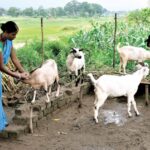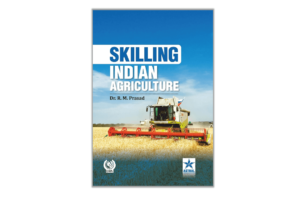Balakumar Thangavelu and Vidhya Bhojan (2024)
Publisher: Notion Press
ISBN: 979-8-89446-817-4
Price: INR 299
As I continue to explore my subject, extension education, I find myself drawn to concepts that resonate with my exploration. One such concept is volunteerism. In today’s capitalistic society, where everything has a price, the desire to contribute without expectation of payment or compensation stands out as a powerful and untradeable act.
When I searched for books on volunteerism, I found only a handful, most of which were written by foreign authors. Then, unexpectedly, I came across 101 Impactful Ways to Volunteer – unleash the volunteer within you, like we did! by Balakumar Thangavelu and Vidhya Bhojan. The absence of reviews on Amazon or Flipkart initially made me hesitant, but after learning more about the authors, I decided to give it a chance. Here is my review of the book.
As the title suggests, this book presents 101 ways to volunteer. Before listing these methods, the authors provide a brief introduction to volunteerism and share their personal experiences with it. The book can thus be divided into two parts: an introduction to volunteerism (the first 50 pages) and 101 practical ways to embark on your volunteering journey (the rest of the pages).
In the first part, the authors outline their individual journeys in volunteering and reflect on how these experiences have shaped them. Balakumar Thangavelu, affectionately known as Bala, emerges as the non-fictional protagonist of the book, as portrayed by Vidhya Bhojan. The book is structured around a series of questions Vidhya poses to Bala about volunteerism, with Bala providing thoughtful responses. Meanwhile, in some places, Vidhya is also sharing her volunteering moments.
The authors introduce the concept of volunteerism, tracing its evolution, benefits, and boundaries. They debunk common myths and offer practical tips for getting started. Bala’s experiences, particularly during the COVID-19 pandemic, offer a compelling insight into the significance of volunteering. This section concludes with Bala outlining critical success factors for volunteering and presenting a volunteering matrix to categorise activities by sector, mode, and duration.
The second part of the book details 101 impactful ways to volunteer. Each method is presented in a tabular format that utilises the volunteer matrix introduced earlier. The table includes details such as the sector, target audience, mode, duration, location, needs, execution steps, prerequisites, outcome metrics, and tips. The sectors covered include animal care, community, education, environment, healthcare, and pro bono work. The modes of volunteering are categorised as in-house physical, in-house virtual, and in-person physical. Volunteering durations are classified as micro (less than an hour), standard (2-4 hours), and long-term (more than one session). Overall, this section serves as a comprehensive catalogue of impactful ways to volunteer across different sectors, modes, and durations. Readers can simply choose the approach that suits them best and begin their volunteering journey.
Has this book helped me in my exploration? Absolutely. It gave me a perspective on how to integrate volunteerism in extension. If extension work does not incorporate volunteerism, we are missing a vital component. Extension, as a discipline that works with and for the community, should inherently embrace and promote the value of volunteerism.
I believe that volunteerism presents numerous opportunities for agriculture students to enhance their interpersonal, problem-solving, and networking skills. Reflecting on the work of the AESA Network which we host at CRISP, I can see that much of its success is due to the dedication of extensionists from across South Asia. These individuals volunteer their time and expertise to help develop a more relevant cadre of extensionists, both within the region and beyond. There is also a need for more volunteers to contribute their knowledge to AESA, to spread its reach, and to educate and train the next generation of extensionists who will address the challenges of tomorrow.
In conclusion, this book is not sector-specific, even though the authors describe it as “an easy guide for CSR professionals, HR professionals, NGOs, academicians, and individuals.” It is a resource for anyone who wants to contribute but doesn’t know where to start. As the authors emphasise, the 101 ways presented are merely suggestions and can be adapted to suit various contexts. Extensionists, in particular, can customise many of these suggestions and begin their own volunteering journey.
D. Alagu Niranjan

D. Alagu Niranjan is a Research Fellow with the Centre for Research on Innovation and Science Policy (CRISP), Hyderabad, India. He can be reached at: dan131995@gmail.com









The title of the book appears very interesting. This book assumes significance in today’s materialistic society which is dominated by selfishness, the root cause of many ills in our society. Selflessness is a virtue which we need to nurture and inculcate among others. We need to help others with selflessness i.e. without any expectations. The basis of Volunteerism is selflessness. Today’s society which is fraught with inequality, poverty, disease, exploitation of weak by the strong, challenges posed by natural calamities etc. needs voluntary service more than ever before. I understand the authors have indicated several ways of volunteerism to help the society. This book I am sure definitely helps motivating more and more people to become volunteers to render selfless service to the needy. Fortunately, anybody irrespective of his position, education, wealth etc. can become a volunteer.
The essence of Mahabharat in one sentence as told by Sage Vedavyas was “You get Punyam if you Help others and you get Sin if you Harm others.”
It is in this context the authors need to be complemented for publishing this book to inculcate volunteerism among the people. I thank the reviewer Dr Alagu Niranjan and AESA for publishing a review of this book.